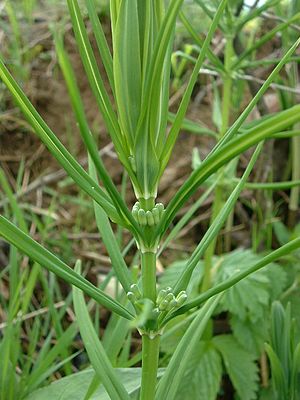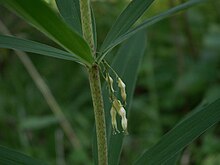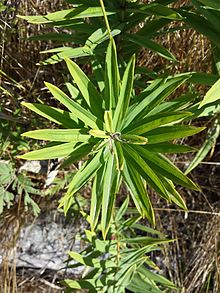Whorled Weisswurz
| Whorled Weisswurz | ||||||||||||
|---|---|---|---|---|---|---|---|---|---|---|---|---|

Whorl-leaved white root ( Polygonatum verticillatum ) |
||||||||||||
| Systematics | ||||||||||||
|
||||||||||||
| Scientific name | ||||||||||||
| Polygonatum verticillatum | ||||||||||||
| ( L. ) All. |
The Polygonatum Verticillatum ( Polygonatum verticillatum (L.) All. , Syn. : Convallaria verticillata L. ), also whipper's seal , belongs to the family of asparagaceae (Asparagaceae).
Other German names are or were Blutwurz ( Augsburg ), Wilder Dreyocker ( Silesia ), Schlangenkraut (Silesia) and Weisswurz .
description
The perennial geophyte is mainly found in shady forests. It has thick, fleshy rhizomes . The plant has a stature height of 40 to 100 cm. The stem stands upright, with narrow leaves standing in a whorl. The white, bell-shaped flowers are axillary and bisexual. The berries are first red, later black-blue. The plant is poisonous, especially the berries.
The chromosome number of the species is 2n = 28.
ecology
Because of the relatively short corolla tube, pollination takes place not only by bumblebees but also by long-nosed bees and by smaller moths . The flowering period is from May to June.
General distribution
The area of this praealpin widespread species extends from the Arctic Circle in Norway across Central Europe, Asia Minor, the Caucasus to Afghanistan. It occurs almost all over Europe, is absent in Great Britain and Ireland and is limited to the mountains on the Iberian Peninsula.
Locations
The whorl-leaved Weisswurz needs loamy soil with ample admixture of not too well decomposed humus . As a result, the soil reacts slightly acidic and often remains loose. Humidity at the location is advantageous. The type prefers deciduous and coniferous forests as locations, especially in the valleys of the low mountain ranges, but also in humid hillside forests. In Central Europe it occurs particularly in montane fagetes, also in Alnetum incanae and in societies of the Adenstylion.
In the Alps, it rises to over 2000 m and occasionally goes over shady meadows and meadows. In the Allgäu Alps, it rises in Vorarlberg at the Ochsenhofen heads up to 1950 m above sea level.
She avoids pronounced warm and dry areas. In the lowlands and in the lower elevations of the low mountain range it occurs only sporadically, and in large areas of Central Europe it is absent; otherwise it appears scattered and usually forms smaller, often loose stocks.
use
The starchy roots can be eaten cooked. Young shoots can be prepared like asparagus .
literature
- L. Roth, M. Daunderer & K. Kormann: Poison plants - plant poisons. Nikol Verlagsgesellschaft mbH & Co. KG, Hamburg, 1994, ISBN 3-933203-31-7
- Ruprecht Düll , Herfried Kutzelnigg : Pocket dictionary of plants in Germany and neighboring countries. The most common Central European species in portrait. 7th, corrected and enlarged edition. Quelle & Meyer, Wiebelsheim 2011, ISBN 978-3-494-01424-1 .
- Oskar Sebald, Siegmund Seybold, Georg Philippi: The fern and flowering plants of Baden-Württemberg , Ulmer Verlag, Volume 7
- Dietmar Aichele, Heinz-Werner Schwegler: The flowering plants of Central Europe , Franckh-Kosmos-Verlag, 2nd edition, volume 5
Individual evidence
- ^ Carl Jessen , The German folk names of plants , published by Philipp Cohen Hannover 1882, page 108
- ↑ a b Erich Oberdorfer : Plant-sociological excursion flora for Germany and neighboring areas . 8th edition. Stuttgart, Verlag Eugen Ulmer, 2001. ISBN 3-8001-3131-5 , p. 137.
- ↑ Erhard Dörr, Wolfgang Lippert : Flora of the Allgäu and its surroundings. Volume 1, IHW, Eching 2001, ISBN 3-930167-50-6 , p. 336.
Web links
- Polygonatum verticillatum (L.) All., Whorl white root In: FloraWeb.de.
- Whorled Weisswurz . In: BiolFlor, the database of biological-ecological characteristics of the flora of Germany.
- Profile and distribution map for Bavaria . In: Botanical Information Hub of Bavaria .
- Plants for a future
- Polygonatum verticillatum (L.) All., Map for distribution in Switzerland In: Info Flora , the national data and information center for Swiss flora .
- Distribution in the northern hemisphere according to Eric Hultén
- Thomas Meyer: Data sheet with identification key and photos at Flora-de: Flora von Deutschland (old name of the website: Flowers in Swabia )

